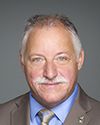Good morning, Mr. Chair, ladies and gentlemen.
I'll be speaking specifically on commemorating the military service and sacrifice of our indigenous peoples.
Canada's indigenous peoples have a proud tradition of military service. While exact numbers are difficult to determine, the rate of indigenous participation in Canada's military has been significant. It is estimated that more than 12,000 indigenous people from Canada served in the two world wars, the Korean War and in more recent international peace support efforts, with at least 500 of them losing their lives.
These determined volunteers often had to overcome challenges in their quest to serve, from learning a new language and adapting to cultural differences to travelling long distances from remote communities just to enlist, and to share in the cause of peace.
From the commemoration perspective, our department has traditionally marked the military service of indigenous peoples within activities and programming aimed at remembering the service of Canadian veterans more broadly.
The spirit of this approach was perhaps most eloquently captured by Mr. James Brady, when he was asked about his service in the context of his identity as a member of the Métis community. Reflecting on the service of indigenous veterans during the Second World War, Mr. Brady said:
...true destiny is not bound by the success or failure attendant upon Métis deliberation.... It is bound up with our continued existence as Canadians who fight [for] those liberties to which we are all devoted....
In modern times, our government takes its sacred obligation to recognize and honour the contributions of our veterans very seriously. While the conflicts of the 20th century have proven that peace is very costly to individuals, families, and communities, we have also learned that peace is a journey rather than a destination; peace is fragile and sacred; and peace is essential for Canada.
In honouring and respecting this fundamental and universal Canadian value, our program is committed to finding inclusive and culturally relevant ways to engage youth and raise awareness of those who have contributed so much to what we, as Canadians, hold so dear.
In 2005, the Year of the Veteran, the Government of Canada, through VAC's commemoration program, supported an aboriginal spiritual journey to the battlefields and cemeteries of Europe. While previous commemorative journeys had included indigenous veterans and other representatives, the aboriginal spiritual journey focused exclusively on the traditions that Canada's indigenous peoples have used throughout the ages to pay tribute to fallen warriors.
The journey would serve as a source of healing for all indigenous veterans and their families. It offered spiritual elders from communities across Canada, as identified and selected by an Aboriginal Veterans Working Group, the honour of leading ceremonies at key Canadian commemorative sites in Europe based on indigenous custom. This included the opportunity for indigenous spiritual leaders to conduct a “Calling Home” ceremony, during which the spirits of fallen warriors were called home to the ancestral lands they left when they embarked for Europe.
The journey was inspired by the efforts of several leaders from Canada's indigenous community, including Mr. Ed Borchert, past president of the National Metis Veterans Association, and Mr. Ray Rogers, former chairman of the First Nations Veterans of Canada.
Who were the driving forces behind this initiative? The Aboriginal Veterans Working Group included senior representatives from Canada's various indigenous peoples who jointly developed the journey program. Delegates included indigenous veterans of the Second World War and senior indigenous leaders of the day, as well as indigenous elders and youth. In addition to veteran representatives the program incorporated significant indigenous cultural elements.
From the commemoration program perspective, the journey—called the “aboriginal spiritual journey” back in 2005—helped increase awareness within Veterans Affairs Canada and the Government of Canada of the importance of remembering the service and sacrifice of indigenous people over the years. Significant efforts have since been made to ensure that Canada's indigenous veterans are honoured throughout program activities led by Veterans Affairs.
Commemorating indigenous veterans is highlighted now through the commemoration program's different areas of responsibility, which are: our overseas and domestic activities; the books of remembrance and the Canadian virtual war memorial; our commemorative partnership program; memorials that are national and international symbols; our Heroes Remember programs and interviews; the Minister of Veterans Affairs commendations; our European operations, such as, for example, our new Vimy visitor education centre located in Vimy, France; and, finally, our learning program.
VAC's commemorative learning program, for example, includes material related to indigenous veterans' service. The program and topical learning materials distributed annually reach hundreds of thousands of Canadian youth in hundreds of schools from coast to coast to coast. The program shines a spotlight on the experiences of individuals as a way to illustrate the overall service of the larger indigenous community, including the indigenous soldiers, foreign battlefields, historical booklets, and an indigenous veterans historical sheet and other print and online resources that tell stories of the individual service personnel as part of the larger narrative of indigenous military service.
In conclusion, the commemoration of Indigenous people who have proudly served in Canada's military is a clearly demonstrated element within VAC's broader Canada Remembers Program.
As the Canada Remembers Program seeks to build on its Road to Peace theme over the coming years, elevating and enriching the national dialogue on remembrance in our country, VAC will seek out appropriate opportunities to promote remembrance of indigenous veterans' achievements and sacrifices. These efforts will naturally include increasing awareness on the service of indigenous peoples.
VAC-led commemorative activities will increasingly focus on engaging younger veterans and youth in commemorating our military history and heritage, including the proud role of Canada's indigenous peoples, in communities across the country and overseas.
I thank you for having granted me some of your time today. My colleague Maryse Savoie will now conclude our presentation.



